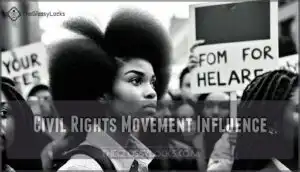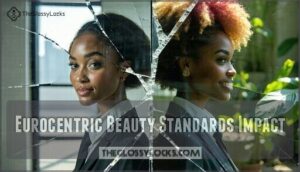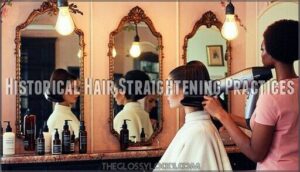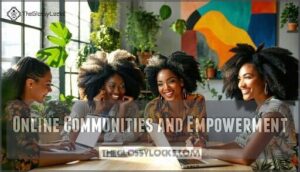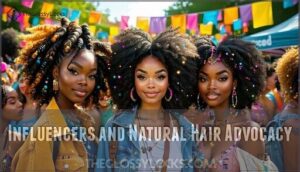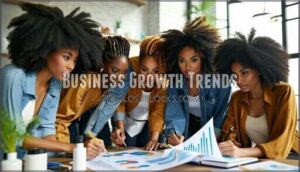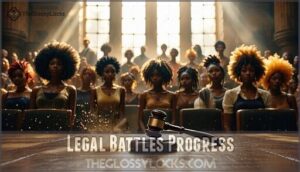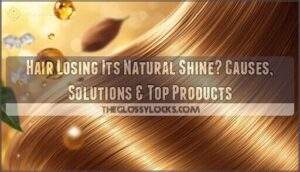This site is supported by our readers. We may earn a commission, at no cost to you, if you purchase through links.
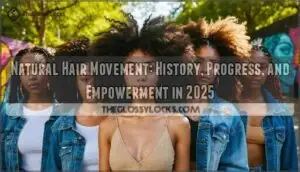
Born from the fight against Eurocentric beauty standards, it roots itself in self-love and cultural pride.
Think of it as a revolution for your strands—where twist-outs, wash-and-gos, and protective styles shine unapologetically.
Social media brought tribes together, sharing tips, routines, and stories, often fueled by products from Black-owned brands that truly “get” textured hair.
Laws like the CROWN Act even protect your right to rock your natural hair.
Ready to explore the history, trends, and triumphs behind this movement? Let’s keep going.
Table Of Contents
- Key Takeaways
- Natural Hair History
- Social Media Impact
- Business Growth Trends
- Legal Battles Progress
- Cultural Significance
- Frequently Asked Questions (FAQs)
- Why did the natural hair movement start?
- What was the 70s natural hair movement?
- How do you describe the movement of hair?
- How do climate conditions affect natural hair?
- What are common misconceptions about natural hair?
- Can natural hair benefit overall scalp health?
- How does aging impact natural hair texture?
- What are the economic impacts of transitioning to natural hair?
- How does natural hair care affect health?
- What are common misconceptions about natural hairstyles?
- Conclusion
Key Takeaways
- You’re part of a movement with deep historical roots in the Civil Rights era, where natural hair became a powerful symbol of resistance against Eurocentric beauty standards and white supremacy.
- You’ll find strength in online communities and social media platforms that have transformed the natural hair movement into a global force, providing tutorials, support, and a sense of belonging.
- You’re witnessing unprecedented business growth in the natural hair industry, with Black-owned brands leading innovation and celebrities helping reshape beauty standards to be more inclusive.
- You’re protected by emerging legislation like the CROWN Act, which fights race-based hair discrimination in workplaces and schools, though the battle for complete legal protection continues.
Natural Hair History
You’ve probably noticed how hair is never just hair—it’s culture, identity, and history all rolled into one.
From afros in the Civil Rights era to decades of battling eurocentric beauty ideals, natural hair tells a powerful story of resistance and pride.
Civil Rights Movement Influence
During the Civil Rights Movement, natural hair became more than a style—it was a political statement.
Natural hair during the Civil Rights Movement symbolized defiance, identity, and the unapologetic power of cultural pride and resistance.
Icons like Angela Davis rocked massive afros, turning Black hair into a symbol of cultural resistance and pride.
The Black Power movement didn’t just embrace Afro symbolism; it demanded hair equality, challenging race-based hair discrimination and redefining beauty within the natural hair movement.
Many find a natural hair journal helpful in this process.
Eurocentric Beauty Standards Impact
The push for straightened hair desirability stems from historical beauty ideals rooted in Eurocentrism and white supremacy.
Cultural assimilation encouraged Black women to adopt styles considered "professional" under these standards, fueling internalized racism.
Hair politics emerged as a response to:
- Media promoting straight hair as superior.
- Workplace bias against natural styles.
- Racial discrimination shaping beauty norms.
- Social pressure to conform appearances, which is a result of historical beauty ideals.
Historical Hair Straightening Practices
Straightening hair has a tangled past. Hot combs, perms, and chemical relaxers rose in popularity, driven by Eurocentric ideals and cultural assimilation pressures.
Here’s a quick look:
| Timeline | Tool Used | Purpose | Impact |
|---|---|---|---|
| Late 1800s | Hot Combs | Smooth texture | Painful, lengthy process |
| Early 1900s | Chemical Relaxers | Straighten permanently | Scalp damage concerns |
| 1940s-1970s | Perms | Hold straight styles longer | Fashionable, high-maintenance |
| Present Insights | Safer Options | Minimize damage, increase choice | Renewed cultural expression |
Choices, harsh or empowering, reflected survival. Many consumers still purchase modern hot combs, making informed decisions about their hair care, and considering safer options for their needs.
Social Media Impact
You’d be amazed how social media transformed the natural hair movement into a global force of community and empowerment.
From tutorials to stories, it’s where inspiration and advice flow freely, helping you embrace your natural beauty with confidence.
Online Communities and Empowerment
Social media made the natural hair movement a global village.
Online, you’ve got DIY haircare tips, ingredient consciousness, and digital support—all fueling empowerment.
Why join the natural hair community?
- Connect on genuine journeys.
- Stay updated with economic factors shaping haircare.
- Build friendships through community-building.
- Learn real advice from natural hair blogs.
- Celebrate wins with social media cheerleaders.
Influencers and Natural Hair Advocacy
Natural hair influencers are the heartbeat of the natural hair movement.
Through authentic content creation and advocacy impact, they connect with the natural hair community while tackling authenticity challenges.
Brand collaborations fuel awareness, keep it exciting, and build trust.
| Focus Area | Examples | Impact |
|---|---|---|
| Content Creation | Tutorials, product reviews | Builds knowledge, trust |
| Community Building | Hosting events, discussions | Strengthens shared identity |
| Advocacy Impact | Speaking on discrimination | Inspires social change |
Pioneers in Black Beauty Space
It’s inspiring to see how pioneers like Madam C.J. Walker, Annie Malone, and Marjorie Joyner laid the groundwork for the natural hair movement.
Black entrepreneurs, including Rose Morgan and Fred Luster Sr., built Black-owned brands that championed beauty and individuality.
Their innovation fuels today’s thriving natural hair community, proving that creativity and resilience pave paths for change.
Many find that understanding black hair textures is key to a healthy hair journey.
Business Growth Trends
You’ve probably noticed the natural hair business booming, and it’s not just your imagination.
From small Black-owned startups to Hollywood celebrities launching product lines, the industry’s growth is rewriting beauty standards and making healthy, natural haircare more accessible than ever, which is a significant development in the natural hair industry.
Market Transformation and Accessibility
You’ve probably noticed how the natural hair market surged, right? With product innovation and ingredient transparency, the hair care industry now feels more inclusive.
Stores expanded globally, making natural hair products easier to find. You can even find products for less.
Check these out:
- Affordable price points boost accessibility.
- Retailers prioritize Black-owned brands.
- Demand meets diverse global markets.
- Shoppers embrace natural hair movement authenticity.
Growth of Black-Owned Brands
Black-owned brands are shaping the natural hair movement with inspiring innovation and community-driven strategies.
From handmade creations to sustainability-focused lines, entrepreneurs in the hair care industry tackle funding challenges while fueling market expansion.
Companies like Alikay Naturals and Mielle Organics highlight community building and craft natural hair products that celebrate textured hair’s beauty, empowering Black entrepreneurs to redefine industry standards authentically.
Many consumers actively seek specialized products catering to their needs.
Celebrity Influence on Hair Care
After spotlighting Black-owned brands, the natural hair movement thrives with celebrities shaping hairstyle trends.
Their brands and product endorsements build visibility and reshape beauty standards.
- Tracee Ellis Ross launched Pattern for curl care.
- Issa Rae spotlights Black beauty with cultural impact in social media campaigns.
- Gabrielle Union’s Flawless celebrates natural hair tutorials to empower users.
Representation matters and inspires inclusivity.
Legal Battles Progress
You’ve seen how fighting for natural hair rights has shaped the movement’s legacy.
But legal battles have been key to real change, from the landmark CROWN Act to court cases like Jenkins v. Blue Cross, progress has been steady, even if the road’s been bumpy.
Jenkins V. Blue Cross and Hair Rights
When you think about Afro discrimination, the Jenkins v. Blue Cross case set a bold legal precedent in addressing workplace bias.
This 1976 lawsuit highlighted how rigid hair policies targeted Black employees embracing their racial identity.
Though it didn’t completely erase race-based hair discrimination, it fueled the natural hair movement, encouraging challenges to unfair practices rooted in outdated stereotypes.
The CROWN Act and Anti-Discrimination
The CROWN, a major win for the natural hair movement, fights race-based hair discrimination in workplaces and schools.
It challenges biased policies, protecting hairstyles tied to culture and identity like braids and locs.
Key points:
- It addresses workplace discrimination and hairstyle bias.
- Legal precedents set the stage for change.
- Natural hair legislation empowers individuality.
Some employers also have grooming standards policies that must be considered.
Ongoing Legislation for Hair Protection
Twenty-seven states now protect against race-based hair discrimination, championing natural hair rights and workplace fairness.
While the CROWN Act tackles legislative challenges ahead, federal inaction leaves gaps.
Past hairstyle discrimination cases highlight the need for consistent protections, and advocates push for stronger workplace hair policies, but natural hair legislation faces hurdles—raising awareness is key to ensuring lasting legal protection for all.
Cultural Significance
You can’t talk about the natural hair movement without recognizing its deep cultural roots and significance.
From the Tignon Laws forcing Creole women to cover their hair to today’s celebration of natural textures, it’s always been about reclaiming identity and challenging imposed beauty norms.
Tignon Laws and Creole Women
Imagine this: Creole women in 18th-century Louisiana forced to wrap their hair under Tignon scarves, thanks to laws designed to suppress their beauty and status.
Creole women turned Tignon scarves into vibrant symbols of defiance, transforming oppression into bold statements of beauty and resilience.
These “hairstyle restrictions” masked African and Creole identity but ignited cultural resistance.
They turned scarves into bold fashion, defying a rigid social hierarchy.
This piece of natural hair history showcases resilience under oppressive systems.
- Key points:
- Tignon Laws aimed to suppress beauty.
- Creole women redefined scarves as bold statements.
- Hairstyle choices became cultural resistance.
- Natural hair culture shows enduring resilience.
Madam C.J. Walker’s Legacy
Madam C.J. Walker’s entrepreneurial spirit left a lasting influence on Black hair and beauty culture.
Her business empire revolutionized natural hair history, empowering women through innovative haircare.
Beyond creating products, her philanthropic efforts supported civil rights movements, proving beauty and activism go hand in hand.
Walker’s business legacy inspires the natural hair movement, reflecting resilience and pride in Black hair.
Embracing Natural Hair Identity and Heritage
Your natural hair journey is more than styling—it’s a celebration of heritage and cultural pride.
Embracing natural hairstyles expresses identity and challenges outdated hair politics. You’re reclaiming self-acceptance, affirming that Black hair is powerful and beautiful.
Each afro, twist, or loc honors history while redefining norms. The natural hair movement empowers you to wear your legacy proudly and unapologetically.
A useful tool for this journey is a natural hair journal to track progress, and it helps in redefining your natural hair journey.
Frequently Asked Questions (FAQs)
Why did the natural hair movement start?
The movement emerged as a celebration of Black identity, resisting Eurocentric beauty ideals.
It’s about reclaiming cultural pride, embracing natural textures, and challenging discrimination while promoting self-expression, equality, and freedom through hair.
What was the 70s natural hair movement?
The 70s witnessed your crowning glory rebellion.
You embraced afros and natural styles as political statements against Eurocentric beauty standards, continuing the momentum from the 60s Civil Rights Movement and Black Power ideologies.
How do you describe the movement of hair?
You can describe hair movement as the way your strands flow, bounce, or sway in response to air, motion, or styling.
It’s characterized by volume, flexibility, and the natural rhythm it creates.
How do climate conditions affect natural hair?
Like a delicate plant in changing seasons, your natural hair responds dramatically to humidity, dryness, and temperature.
You’ll need specific products and protection methods as climate conditions can cause frizz, breakage, and moisture loss.
What are common misconceptions about natural hair?
You’ll find many believe natural hair is hard to maintain, unprofessional, or "just a phase."
In reality, your curls and coils aren’t difficult—they’re simply different, requiring specific care techniques suited to your unique texture.
Can natural hair benefit overall scalp health?
Your natural crown thrives when free from harsh chemicals.
You’ll experience less breakage, reduced scalp irritation, and improved circulation when you embrace your natural texture.
Your scalp can breathe and regulate oil production naturally.
How does aging impact natural hair texture?
As you age, your natural hair gradually becomes thinner and drier, with hormonal changes affecting curl pattern and elasticity.
You’ll notice graying combined with texture changes that might require adapting your care routine to address the hormonal changes.
What are the economic impacts of transitioning to natural hair?
You’ll save substantially by ditching salon visits and chemical treatments, though initial natural hair products can be costly.
Over time, you’ll develop simpler routines that require fewer products, creating substantial long-term savings.
How does natural hair care affect health?
Your health improves when you ditch chemical relaxers.
You’ll reduce scalp irritation, minimize hair breakage, and lower your exposure to harmful chemicals.
Plus, your natural curls can thrive without constant heat damage.
What are common misconceptions about natural hairstyles?
You’ll often hear that natural hairstyles are high-maintenance, unprofessional, or less versatile than straightened styles.
These myths overlook the versatility, historical significance, and healthy self-expression that embracing your natural texture provides.
Conclusion
Remember when straight hair was the only "professional" option?
Look how far we’ve come!
Today’s natural hair movement isn’t just about products or styles—it’s about reclaiming your identity and honoring your roots.
Whether you’re just starting your journey or you’ve been rocking your texture for years, your curls tell a powerful story.
Keep celebrating, advocating, and loving your natural hair.
This revolution isn’t just changing beauty standards—it’s changing lives.
- https://www.eeoc.gov/eeoc/newsroom/release/9-30-13j.cfm
- https://www.jstor.org/stable/26505328?mag=how-natural-black-hair-at-work-became-a-civil-rights-issue
- https://daily.jstor.org/how-natural-black-hair-at-work-became-a-civil-rights-issue/
- https://www.allure.com/story/immigrants-in-beauty-ouidad-founder
- https://www.youtube.com/watch?v=-h0a2HaORU8

